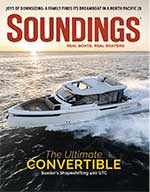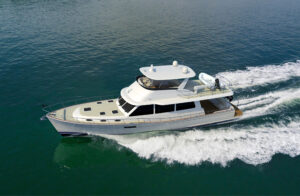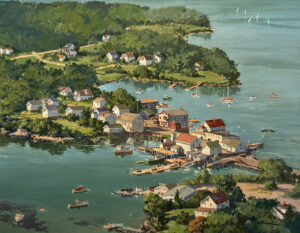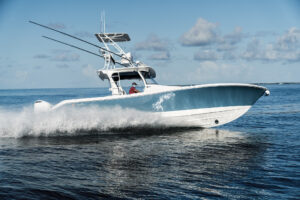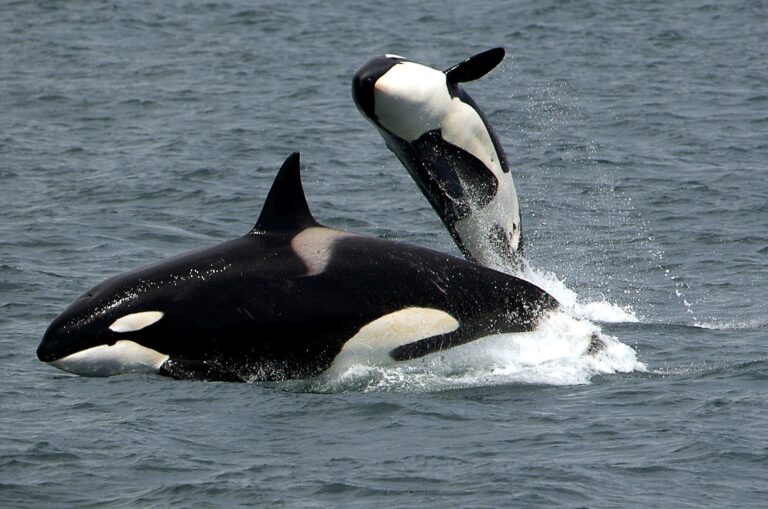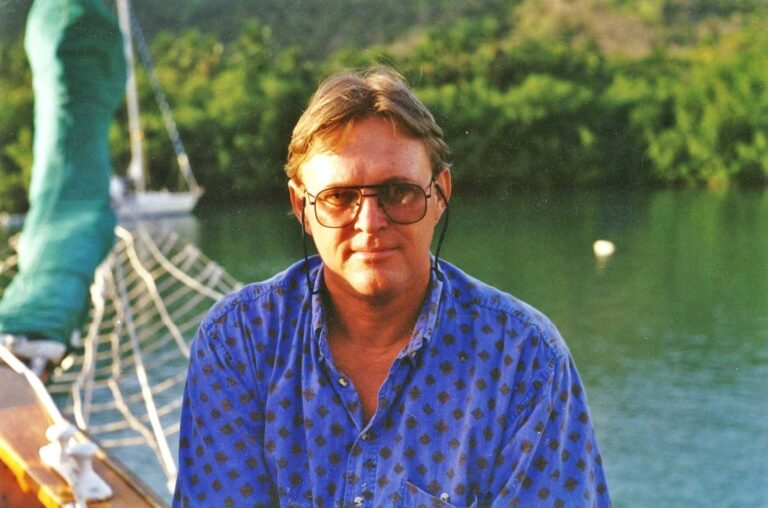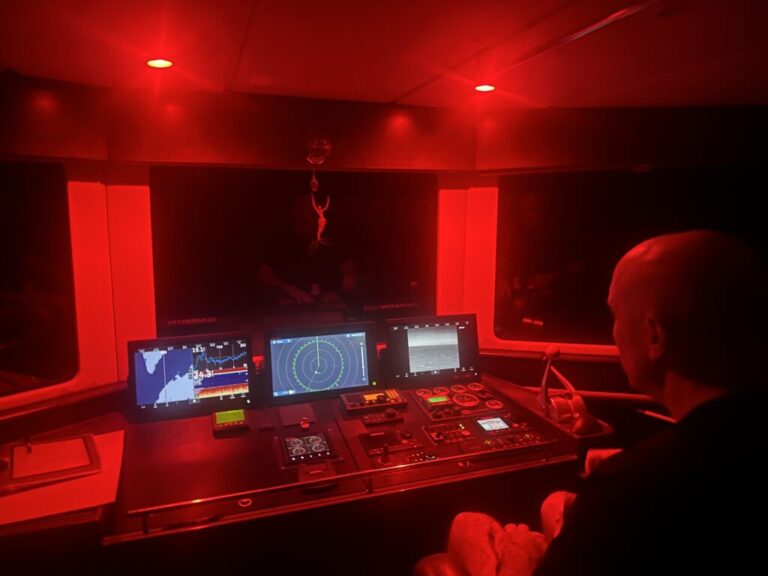Never tell Bob Lico it can’t be done. To him, that’s not advice, it’s a challenge.
Bob, 78, grew up on the shores of Great South Bay on Long Island, New York, where he had his first boat at age 6. A union electrician by trade, he’s a hands-on guy who loves restoring boats and cars. He’s owned 14 classic Corvettes and a fleet of offshore race and fish boats, and he holds a 100-ton master’s certification that comes in handy for his part-time charter captain gig.
Bob’s son Anthony, 54, also grew up a water baby with boating credits that stretch back to early childhood. He is an electrical contractor and has the uncanny ability to fabricate pretty much anything he and his father can dream up. That skill came in handy when father and son teamed up to restore an old Bertram 31.

The first time I met the Licos was in Montauk in 2008 while covering a Bertram 31 Club rendezvous at Snug Harbor Marina. While walking the docks, I saw Bob holding court from the cockpit of his beautiful 1973 sportfish model. Emblazoned on the transom in large black letters was the name Phoenix. The boat stood out from the rest. Its look was fresh, clean and functional with a blue hull, gleaming white house and bridge, sparkling bright work, unique helm seating, and a one-off Bimini-style top and enclosure. I listened as Bob told other Bertram owners about the modifications he and Anthony had executed to bring the old boat back to life. .
The next day, when all the club boats hit the water for a photo shoot, Phoenix shined. It was the fastest 31 by far, exhibiting a different stance and angle of attack. It ran like a waterborne sports car, carving tight turns and powering past other boats with ease. In my mind, Bob and Anthony had created a hybrid 31 with performance characteristics and amenities of a modern boat.
Since then, the Licos have continued to improve and refine Phoenix while using it for fishing and cruising with family and friends. They run it to distant and nearby beaches on the weekends, out to the canyons for tuna and inshore for striper fishing. No matter where Phoenix shows up it becomes the center of attention.

“As pretty as she is, she’s a fish boat at heart,” Bob said during a recent conversation we had aboard the boat at its slip in Blue Point, New York. Father and son showed me the changes that had been made to Phoenix since her debut 15 years earlier.
Having tired of his Hydra-Sport center console, Bob was searching for a 31 Bertram in 1999 when he saw his future boat in a brokerage listing from Oakdale Yachts. A deal was made and Bob began the process to create his dream boat. It began with six years of radical alterations.
“When my dad called me to come see the boat, I had no idea what to expect,” said Anthony. “When I got there both of the original engines were already in the parking lot alongside the hull.”
The engines were replaced by a pair of 330-hp Cummins diesels, but not before a host of changes were made that would dramatically impact the performance of the boat. The remanufactured engines were set back 5 inches and dropped deeper into the hull, where they would rest almost level on a set of titanium motor mounts fashioned from the mounts of an F14 fighter jet found in an aircraft graveyard. Repositioning the engines required altering the prop shaft angle two degrees higher, but that was part of the plan to change the boat’s ride angle and rebalance it with a lower center of gravity. It took some highly technical glass work to accomplish, and like most of the work on the boat, Bob and Anthony did it themselves. They moved access to the engine’s service items to centerline for ease of maintenance and fabricated their own thermostatically controlled block heaters and a more efficient oil change system. The engines rest under redesigned cowlings with removable side boards.
The engines are mated to ZF transmissions connected to stainless prop shafts with special seals and bushings, turning one-of-a-kind props designed by Bob to take advantage of the Cummins’ strong torque curve.
The 21-inch Nibral props started as 23-inchers so they could be reworked to incorporate a dramatic cup, something rarely seen on inboard boats. Ron Ellis—the prop wizard at Bozler & Sweezy in Bellport, New York— told Bob it couldn’t be done, but that only encouraged him. Relenting, Ellis made it happen. In case you’re wondering, the props work like a charm giving the boat more bite, quicker acceleration, higher top speed and improved cruising economy. The cupped props also affected the boat’s ability to make tight turns without slip.

Bob explained their choice of the 330-hp Cummins over higher horsepower engines with the same displacement. “It’s all about torque, not horsepower. Torque spins the props, and all of the engines in that series shared a similar torque curve regardless of horsepower rating,” he said. “By utilizing the torque more efficiently, I could get the same or better performance with the lowest horsepower model and with less strain on the internal engine components. That means greater longevity and less fuel burned.”
To better utilize the engine’s torque Bob devised a better way for the diesels to inhale and exhale. First, he designed a cold-air intake system that draws outside air from the cockpit through large K&N air filters and directly into the engines. (On a stock Bertram 31, air enters the engine compartment through gunwale-mounted clamshell vents that also allow moisture and salt spray to enter.) The pair then installed massive six-inch-diameter exhaust systems routed through MiniMax mufflers that greatly reduced back pressure. The mufflers’ internal baffling negated the need for surge tubes. These modifications improved engine power output by close to 20 percent with the added bonus of keeping the engine boxes dry and salt free. After 16 seasons, the engines are still clean and white with no sign of corrosion.
To improve handling, the men installed HyDrive hydraulic steering, which required redesigning the rudder post support system. Bob designed oversized rudders that completed the steering system. Thanks to the props and rudder system the boat carves turns like a slalom skier and with the engine mods the old Bert performs better than others with higher horsepower engines. To lower the center of gravity they moved the batteries from outside the engines to a central location under the companionway step, repositioned the freshwater tank and replaced the old hot water heater with a lighter, modern design. These changes, coupled with the reverse chine, reduced the hull’s tendency to roll.

The transom was finished with a pair of Gemlux scuppers. Other upgrades included a rewired electrical system using braided silver-plated cabling. The bilge was split into a wet bilge aft and a dry bilge forward of the main bulkhead so there is never water (or mildew or mold) under the cabin deck. The dry bilge has a pump, float switch and high-water alarm just in case, but they have never been needed.
The flybridge helm was redesigned with custom captain’s chairs, a teak helm pod, and a Bimini-style soft top and enclosure. The clear panels can be removed and the top folded back to enjoy warmer weather. The lines of the pipework are raked and symmetrical, with no crossbars to interrupt the forward view from the helm. The Bimini was designed by Bob and Anthony and fabricated by Dorimar Canvas in Sayville, New York. A pair of outriggers were mated to the top, and a unique gin pole that doubles as a quick step up to the bridge was mounted to the starboard gunwale to replace the awkward ladder system that came with the boat.
Additional modifications have been made since 2008. Some enhance cosmetics and comfort, others have improved the performance and fishability of the boat.

Anthony did a major refit of the cabin. It included new mahogany and Ipe flooring, a hand-made teak and holly table with bench seats, a new head compartment with Jabsco porcelain toilet, and a simplified galley area with a modern refrigerator, coffee maker and microwave. He built a pocket door for the head area and added Corian counter tops throughout. They also removed the side and aft cabin windows and replaced them with one-way tinted limousine glass with custom gasketing. They replaced the forward windshield and aluminum frames with a Homesly fiberglass kit. Later, Anthony removed the Glasstek cockpit deck installed by the previous owner and built his own using Coosa composite material for another huge weight savings. He included two large fish box hatches and bilge and lazarette access hatches.
In 2017, the father-son duo accomplished a big job: They installed a large Airmar thru-hull transducer flush on the centerline of the hull so it would not create any drag. This required cutting a major hole in the keel, fabricating an intricate recessed housing and glassing it in place. That was followed by new Furuno electronics. During that refit the Licos replaced the headliner in the cabin but not before making two large overhead panels that opened into the space behind the helm where the electronics are mounted. The wiring for the system runs through a central backbone computer that is kept high and dry inside the space that would have otherwise been wasted. They also replaced all the lighting with low-draw LEDs, which allowed them to ditch the old genset in favor of an inverter system with separate batteries. It can operate everything on the boat, including the air conditioning, for up to three days without recharging and accounted for another major weight reduction.

Finally, Anthony fabricated a new radiused dash for the helm with curved eyebrows that shield the two MFDs from direct sunlight. He also added teak padded arms and ladder backs to the side-by-side helm chairs.
When asked if the boat was finished, Anthony replied, “It’s never done. This winter we are taking out the cabin’s aft bulkhead and building a redesigned replacement. We have a few other items to take care of in addition to maintenance before we splash it for the 2025 season.”
We took Phoenix out for a spin on Patchogue Bay. Both engines, now with 16-seasons on them, cranked over immediately on the first tip of the key and were already warmed up thanks to the block heaters. The wind was howling, and the bay was whipped up with a significant chop, but the boat was unfazed as Bob pushed the throttles to a 26-knot cruise. Bertram 31s are famous for their seakeeping, especially in a head sea, but Phoenix rides differently than stock boats. She’s considerably lighter and the ride angle is more level, with a subdued proudness at the bow. The boat is so well-balanced bow to stern and gunwale to gunwale that it has no need for trim tabs. Bob ran her into the sea, then beam-to and finally crossed the building waves at varying angles. The ride was surprisingly comfortable, smooth, quiet and fast. He pushed it up to an impressive 35 knots, letting the bird fly and she did.
“She’ll do 38 knots with a fresh bottom,” Bob said with a smile. He was enjoying the ride as much as I was.
Bob and Anthony are active on several dedicated websites where they help other B31 owners with restoration projects. Over the winter they will be preparing Phoenix for a run on her own bottom to a much-anticipated B31 Rendezvous in North Carolina, where she’s sure to wow the crowd.
January 2025

